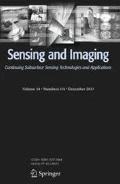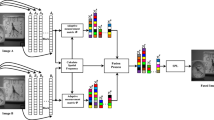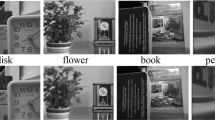Abstract
Image super-resolution reconstruction is an effective method to improve image resolution, but most reconstruction methods rely on the clear low resolution images ignoring the blurred images which are also effective observations of the scene. Aiming at the problem, a super-resolution reconstruction (SRR) method via multi-frame defocused images is proposed. Firstly, according to the image degraded model, we establish the cost function of the point spread function (PSF) and utilize the particle swarm optimization algorithm to estimate it. Then, based on the multi-frame defocused images and PSFs, a joint reconstruction model is established to realize SRR by compressive sensing (CS) theory. In the CS framework, only the interpolated version of the low-resolution image is used for training purpose and the K-Singular Value Decomposition method is used for dictionary training. In addition, to solve the edge effect problem, an internal blur matrix is constructed according to the image blurring process, and a weight coefficient is introduced in the patch splicing process. Experiments show that the proposed algorithm can accurately estimate the defocused image PSF and achieve a good reconstruction effect.










Similar content being viewed by others
References
Tsai, R. Y., & Huang, T. S. (1984). Multiframe image restoration and registration. Advances in Computer Vision and Image Processing, 1, 317–339.
Zhang, Xin, Liu, Qian, et al. (2016). Non-local feature back-projection for image super-resolution. IET Image Processing, 10(5), 398–408.
Rasti, P., Demirel, H., & Anbarjafari, G. (2014). Iterative back projection based image resolution enhancement. In Machine vision and image processing (pp. 237–240). IEEE.
Liu, J., Dai, S., Guo, Z., & Zhang, D. (2016). An improved POCS super-resolution infrared image reconstruction algorithm based on visual mechanism. Infrared Physics & Technology, 78, 92–98.
Liu, H., Sun, K., Sun, H., & Sun, J. (2015). Super-resolution image reconstruction of pocs with edge preserving. Journal of Jilin University, 33(6), 620–624.
Luo, G. Z., Yin, J. P., & Zhu, E. (2014). Super-resolution image reconstruction based on non-local POCS. Computer Science, 41(8), 47–49, 62.
Sun, D., Gao, Q., Lu, Y., Zheng, L., & Wang, H. (2014). A high quality single-image super-resolution algorithm based on linear bayesian map estimation with sparsity prior. Digital Signal Processing, 35, 45–52.
Marcelo, O. C., Evandro, O. T. S., & Mario, S. F. (2012). Super-resolution image reconstruction using nonparametric Bayesian INLA approximation. IEE Transactions on Image Processing, 21(8), 3491–3501.
Sen, P., & Darabi, S. (2009). Compressive image super-resolution. In Asilomar conference on signals, systems and computers (pp. 1235–1242). IEEE Press.
Pan, Z., Yu, J., Huang, H., Hu, S., Zhang, A., Ma, H., et al. (2013). Super-resolution based on compressive sensing and structural self-similarity for remote sensing images. IEEE Transactions on Geoscience and Remote Sensing, 51(9), 4864–4876.
Yang, J., Wright, J., Huang, T. S., & Ma, Y. (2010). Image super-resolution via sparse representation. IEEE Transactions on Image Processing, 19(11), 2861–2873.
Deka, B., Gorain, K. K., Kalita, N., & Das, B. (2013). Single image super-resolution using compressive sensing with learned overcomplete dictionary. In Computer vision, pattern recognition, image processing and graphics (pp. 1–5). IEEE.
Zeyde, R., Elad, M., & Protter, M. (2010). On single image scale-up using sparse-representations. In International conference on curves and surfaces (pp. 711–730).
Jaehwan, J., Inhye, Y., et al. (2010). Fully digital auto-focusing system with automatic focusing region selection and point spread function estimation. IEE Transactions on Consumer Electronics, 56(3), 1204–1210.
Joshi, N., Szeliski, R., & Kriegman, D. J. (2008). PSF estimation using sharp edge prediction. In Computer vision and pattern recognition (pp. 1–8). IEEE.
Mengya, Qu, Yongsheng, Zhang, & Runsheng, Li. (2016). An optimized reconstruction algorithm for point spread function based on slant step edge. Journal of Geomatics Science and Technology, 33(6), 611–616.
Stokseth, P. A. (1969). Properties of a defocused optical system. Journal of the Optical Society of America, 59(10), 1314–1321.
Candès, E. J. (2008). The restricted isometry property and its implications for compressed sensing. Comptes Rendus Mathematique, 346(9), 589–592.
Candès, E., & Romberg, J. (2007). Sparsity and incoherence in compressive sampling. Inverse Problems, 23(3), 969–985.
Donoho, D. L. (2006). Compressed sensing. IEEE Transactions on Information Theory, 52(4), 1289–1306.
Mallat, S. G., & Zhang, Z. F. (1993). Matching pursuit in a time frequency dictionary. IEEE Transactions on Signal Processing, 4(12), 3397–3415.
Tropp, J. A., & Gilbert, A. C. (2007). Signal recovery from random measurements via orthogonal matching pursuit. IEEE Transactions on Information Theory, 53(12), 4655–4666.
Wei, D., & Milenkovic, O. (2009). Subspace pursuit for compressive sensing signal reconstruction. IEEE Transactions on Information Theory, 55(5), 2230–2249.
Figueiredo, M. A. T., Nowak, R. D., & Wright, S. J. (2008). Gradient projection for sparse reconstruction: Application to compressed sensing and other inverse problems. IEEE Journal of Selected Topics in Signal Processing, 1(4), 586–597.
Baraniuk, R. (2007). Compressive sensing. IEEE Signal Process, 52(4), 118–121.
Aharon, M., Elad, M., & Bruckstein, A. (2006). K-SVD: An algorithm for designing overcomplete dictionaries for sparse representation. IEEE Transactions on Signal Processing, 54(11), 4311–4322.
Suetake, N., Sakano, M., & Uchino, E. (2008). Image super-resolution based on local self-similarity. Optical Review, 15(1), 26–30.
Acknowledgements
This work is supported by the project of National Natural Science Foundation of China (61571068) and the innovative research projects of colleges and universities in Chongqing (12A19369).
Author information
Authors and Affiliations
Corresponding author
Rights and permissions
About this article
Cite this article
Mao, Y., Jia, H., Li, C. et al. Super-Resolution Reconstruction via Multi-frame Defocused Images Based on PSF Estimation and Compressive Sensing. Sens Imaging 19, 25 (2018). https://doi.org/10.1007/s11220-018-0210-2
Received:
Revised:
Published:
DOI: https://doi.org/10.1007/s11220-018-0210-2




